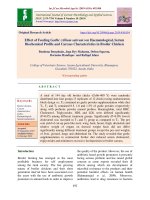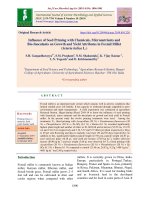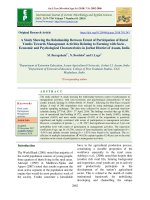Assessment of the correlation and path analysis with association of growth and yield characteristics in Okra
Bạn đang xem bản rút gọn của tài liệu. Xem và tải ngay bản đầy đủ của tài liệu tại đây (218.73 KB, 8 trang )
Int.J.Curr.Microbiol.App.Sci (2019) 8(5): 2331-2338
International Journal of Current Microbiology and Applied Sciences
ISSN: 2319-7706 Volume 8 Number 05 (2019)
Journal homepage:
Original Research Article
/>
Assessment of the Correlation and Path Analysis with Association of
Growth and Yield Characteristics in Okra
Inderpreet Kaur Binepal*, Swati Barche, Mandeep Kaur and K.P. Asati
Department of Vegetable Science, Rajmata Vijayaraje Scindia Krishi Vishwavidyalaya,
Indore - 452001 (MP) India
*Corresponding author
ABSTRACT
Keywords
Correlation
analysis, Path
analysis, Growth
and yields of okra
Article Info
Accepted:
18 April 2019
Available Online:
10 May 2019
The present investigations were conducted at Nursery area, Department of Horticulture,
College of Agriculture, Indore, M.P. during kharif season of 2016. The experiment was
laid out in Randomized Completely Block Design (RCBD) with three replications and
eighteen genotypes were collected i.e. Shakti, Jhilmil, No. 55, Sahiba, No. 64, Harita,
Saarika, Ns-801, Arya Mohini, Shaan, Hissar Unnat, Panchwati, Panchali, Swati, Lakshmi,
OH-102, Shankar Ganga and Parbhani Kranti. The genotype Panchwati was recorded
maximum in growth and yield characters like number of branches plant -1, number of
leaves plant-1, fruit length (16.23 cm), fruit width (2.14cm), fruit weight (17.15 gm),
number of fruit plant-1(14.53), fruit yield plant-1 (292.17gm), fruit yield plot-1 (11.62 kg),
and fruit yield ha-1 (161.28 q). The highest positive and significant correlation coefficient
of fruit yield plant-1 was observed with number of fruits plant-1 and fruit length. The highest
positive and significant correlation coefficient of fruit yield plant -1 has been noted with
number of fruits plant-1 indicating that these characters is the primary yield determinant in
okra. The yield attributing characters exhibited varying trend amongst them. Path
coefficient analysis revealed that number of fruits plant-1 had highest positive direct effect
followed by fruit weight, number of nodes to first flowering, number of branches plant-1 at
90 DAS (days after sowing), length of internodes, number of leaves plant-1 at 90 DAS,
plant height at 90 DAS and fruiting span are the most important character contributing
towards fruit yield and hence purposeful and balance selection based on these character
would be rewarding improvement in okra. Direct selection of fruit yield plant-1, days to
50% flowering, days to first flowering, fruit length and days to first picking should be
avoided instead of direct selection.
Introduction
Okra [Abelmoschus esculentus (L.) Moench]
belongs to the family Malvaceae having
chromosome no. 2n=130 has captured a
prominent position among vegetables. These
studies along with the association analysis
will be more useful in the estimation of interrelationship among the growth and yield
contributing components. It is essential to
have detail information on the association
among different yield components and their
2331
Int.J.Curr.Microbiol.App.Sci (2019) 8(5): 2331-2338
relative contribution to yield. Association
analysis of quantitative attributes would help
in choosing component characters that are
positively correlated.
In addition, an understanding of association
between the component characters is essential
to judge their rational importance. Path
coefficient analysis is also very useful in
formulating breeding strategy to develop elite
genotypes through selection in advanced
generations. Thus, the nature and magnitude
of variability present in the gene pool for
different characters and relationship with each
other determine the success of genetic
improvement of characters. Since the pattern
of inheritance of quantitative characters is
highly complex. Therefore the present
investigation was undertaken to study the
association among different components of
growth and yield and their direct and indirect
contribution to fruit yield in okra.
Materials and Methods
An experiment was conducted at Nursery
area, Department of Horticulture, College of
Agriculture, Indore, MP during Kharif season
of 2016. The experiment was laid out in a
Randomized Completely Block Design with
three replications. The experimental material
consisted of eighteen genotypes of okra. Seed
of germplasm were collected from different
location of India. The seeds were sown in July
in field in fifty four separate plots. The plot
size was kept 4.2 m x 2.5 m. Each plot
consisted of thirty five plants. Correlation
coefficients were calculated in all possible
combinations taking all the characters into
consideration at genotypic, phenotypic and
environmental levels by using the formula as
proposed by Miller et al., (1958).The direct
and indirect contribution of various
independent characters on a dependent
character yield were calculated through path
coefficient analysis as suggested by Wright
(1921) and elaborated by Dewey and Lu
(1959). The following set of simultaneous
equation were formed and used for the
estimation of direct and indirect effects. The
analysis of variance was carried out as per
methods suggested by Panse and Sukhatme
(1967).
Results and Discussion
Correlation coefficient analysis
A wide range of variation in quantitative
characters provides the basis for selection in
plant breeding programme. The knowledge of
association among the characters is useful to
the breeder for improving the efficiency of
selection. Correlation coefficient analysis
measures the mutual relationship between
growth and yield characters of plant and
determines the component character on which
selection can be made for genetic
improvement of yield. Investigation regarding
the presence of component and nature of
association among themselves is essential and
pre-requisite for improvement in yield.
Correlation coefficient provides a clear
picture of the extent of association between a
pair of traits and indicates whether
simultaneous improvement of the correlated
traits may be possible or not.
The knowledge of genetic association
between yield and its component characters
help in improving the efficiency of selection
for yield by making proper choice and
balancing one component with another. The
magnitude of genotypic correlation has been
found higher than the phenotypic correlation
for all the traits that indicated inherent
association between various characters. The
similar findings are in agreement with the
finding of Niranjan and Mishra (2003),
Kumar et al., (2009), Senapati et al., (2011),
Saryam et al., (2015) and Khajuria et al.,
(2016) (Table 1 and 2).
2332
Int.J.Curr.Microbiol.App.Sci (2019) 8(5): 2331-2338
Correlation
components
between
yield
and
its
In the present findings significant positive
phenotypic correlation of fruit yield plant-1
has been observed with fruit weight, number
of fruits plant-1, number of branches plant-1at
90 DAS, number of leaves plant-1at 90 DAS,
fruit width, days to first picking and days to
50% flowering. The highest positive and
significant correlation coefficient of fruit
yield plant-1 has been recorded with fruit
weight, number of fruits plant-1, number of
branches plant-1 at 90 DAS, number of leaves
plant-1at 90 DAS, fruit width, days to first
picking and days to 50% flowering indicating
that these characters are the primary yield
determination in okra. These findings
corroborated with the earlier findings of
Gandhi et al., (2002), Jaiprakashnarayan and
Mulge (2004), Bhalekar et al., (2005),
Nimbalkar et al., (2002), Niranjan and Mishra
(2003), Ghosh (2005), Choudhary (2006) and
Verma et al., (2007) for fruit weight, number
of fruit plant-1, number of branches plant-1 and
fruit width. Yonas et al., (2014) and Saryam
et al., (2015) for fruit weight, number of fruits
plant-1 and fruit width. Khajuria et al., (2016)
for number of fruits plant-1.
Correlation between yield contributing
characters
Plant height at 90 DAS was recorded highly
significant and positive association with
length of internodes. Whereas, highly
significant and negative association with
number of branches plant-1 at 90 DAS. These
results are in corroborated with the findings of
Ali et al., (2008) and Saryam et al., (2015) for
length of internodes. Association of number
of branches plant-1at 90 DAS was recorded
significant and positive with number of fruit
plant-1, fruit yield plant-1, number of leaves
plant-1at 90 DAS, fruit weight, fruit width and
fruit length. These results are in close
harmony with the findings of Saryam et al.,
(2015) for fruit length, fruit width, fruit
weight and number of fruits plant-1and
Sharma and Prasad (2015) for number of
fruits plant-1. Association of number of leaves
plant-1at 90 DAS was recorded significant and
positive with fruit length, fruit width, fruit
yield plant-1, fruit weight and number of fruit
plant-1. The positive correlation of number of
leaves plant-1 at 90 DAS with fruit length,
fruit width, fruit yield plant-1, fruit weight and
number of fruit plant-1 indicates that allocation
and translocation of photosynthates from the
source to the sink. These results are in close
harmony with the findings of Nagre et al.,
(2011) for fruit length and weight.
Association of days to first flowering was
exhibited significant and positive with days
taken to 50% flowering, days to first picking
and number of fruits plant-1. These result
closely similar with the finding of Sharma and
Prasad (2015) for days to 50% flowering and
days to first picking. Days to 50 % flowering
was recorded highly significant and positive
association with days to first picking, fruit
length, number of fruit plant-1 and fruit yield
plant-1. These findings corroborated the
earlier finding of Sharma and Prasad (2010)
for days to first picking and Mishra et al.,
(2015) for days to first picking. Association
of days to first picking was exhibited highly
significant and positive with fruit length, fruit
weight, number of fruit plant-1 and fruit yield
plant-1. These findings corroborated the
earlier finding of Sharma and Prasad (2015)
for number of fruit plant-1. Fruit length
expressed highly significant and positive
correlation with fruit width, fruit weight,
number of fruit plant-1 and fruit yield plant-1.
These findings corroborated the previously
finding of Ghosh (2005) for fruit yield plant-1,
Osekita and Akinyele (2008) for fruit weight
and Saryam et al., (2015) for number of fruits
plant-1and Pachiyappan and Saravannan
(2016) for fruit length.
2333
Int.J.Curr.Microbiol.App.Sci (2019) 8(5): 2331-2338
Table.1 Genotypic path coefficients showing direct and indirect effects of different characters on fruit yield per plant (g) in okra
Characters
Plant
No. of
No. of
No. of
Length of Days to 1st Days to 50%
height
branches
leaves
nodes at internodes flowering
flowering
(cm) at plant-1 at 90 plant-1 at 90 1stflowering
(cm)
90 DAS
DAS
DAS
Plant height
(cm) at 90 DAS
0.2485
-0.5142
-0.0940
-0.0107
-0.0073
0.2541
No. of branches
plant-1 at 90
DAS
No. of leaves
plant-1 at 90
DAS
No. of nodes at
first flowering
0.0933
1.3702
-0.3310
-0.0059
0.0009
0.0437
0.8489
-0.5342
0.0062
0.0622
0.1905
0.0769
Length of
internodes (cm)
0.1256
-0.0855
Days to 1st
flowering
0.0610
Days to 50%
flowering
Fruit
length
(cm)
-0.1270
0.0843
-0.0085
0.1272
0.0107
0.0210
-0.016
-0.2212
0.2041
0.0179
0.1026
-0.3050
0.1463
-0.1657
0.720
-0.0038
0.0222
0.1568
0.0800
0.1620
-0.3132
0.1166
-0.0843
0.501
-0.0427
0.0006
-0.0697
-0.1856
0.1793
-0.0223
0.0337
0.0281
-0.0568
0.194
-0.1410
0.0018
-0.0144
0.0385
0.0167
-0.1594
-0.0177
0.1392
-0.0453
0.0061
-0.135
0.2926
0.0115
-0.0029
0.0005
-1.0357
0.7214
0.3261
0.0104
0.0946
0.0431
-0.0939
0.307
0.0372
0.3300
-0.0988
0.0094
-0.0003
-0.8814
0.8477
0.3189
0.1026
-0.1573
0.0864
-0.0921
0.428
Days to1st
picking
0.0338
0.0395
-0.0689
-0.0124
0.0037
-0.5446
0.4358
0.6201
0.1070
-0.0830
0.1140
-0.1039
0.541
Fruit length (cm)
0.0098
0.6496
-0.3999
0.0044
0.0012
-0.0496
0.4020
0.3065
0.2164
-0.4878
0.1571
-0.1138
0.676
Fruit width (cm)
0.0537
0.7105
-0.2845
0.0024
0.0034
0.1666
0.2267
0.0875
0.1795
-0.5882
0.1053
-0.0834
0.472
Fruit weight (g)
0.0126
0.9521
-0.2957
-0.0057
0.0031
-0.2119
0.3479
0.3357
0.1615
-0.2940
0.2106
-0.1917
1.025
1.1455
-0.2272
0.0263
Residual effect Genotypic: 0.0229
-0.0122
0.0004
-0.4906
0.3938
0.3251
0.1243
-0.2475
0.2036
-0.1982
0.991
No. of
fruitsplant-1
2334
Fruit
Fruit
No. of fruit
width (cm) weight (g)
plant-1
“r” value
Fruit yield
plant-1 (g)
Days to
first
picking
Int.J.Curr.Microbiol.App.Sci (2019) 8(5): 2331-2338
Table.2 Phenotypic path coefficients showing direct and indirect effects of different characters on pod yield plant-1(g) in okra
Characters
Plant
No. of
No. of
No. of Length of Days to 1st Days to
height
branches
leaves nodes at internodes flowering
50%
(cm) at 90 plant-1 at plant-1 at 1stfloweri
(cm)
flowering
DAS
90 DAS
90 DAS
ng
Days to
first
picking
Fruit
length
(cm)
Fruit
width
(cm)
Fruit weight
(g)
No. of
fruit
plant-1
“r” value
Fruit yield
plant-1 (g)
Plant height (cm) at 90 DAS
0.1024
-0.0405
-0.0076 -0.0048
-0.0268
-0.0064
-0.0008
-0.0037 -0.0006 -0.0080
0.0093
-0.0391
-0.027
No. of branches plant-1 at 90
DAS
-0.0295
0.1405
-0.0306 -0.0007
0.0073
0.0036
0.0013
-0.0001
0.0202
0.0179
0.2431
0.2672
0.640
No. of leaves plant-1 at 90
DAS
No. of nodes at first flowering
Length of internodes (cm)
0.0122
0.0674
-0.0638
0.0030
-0.0125
-0.0003
0.0014
-0.0028
0.0313
0.0205
0.2351
0.1762
0.468
0.0224
0.0464
0.0044
-0.0173
0.0088 -0.0218
-0.0135 -0.0008
-0.0020
-0.0591
0.0055
-0.0014
-0.0009
-0.0003
-0.0056 -0.0072 0.0004
0.0071 -0.0036 -0.0084
0.0776
-0.0479
0.0665
-0.0160
0.148
-0.115
Days to 1st flowering
-0.0178
0.0136
0.0005
-0.0033
0.0022
0.0370
0.0050
-0.0112 -0.0004 -0.0062
0.0891
0.1164
0.225
Days to 50% flowering
-0.0112
0.0238
-0.0115
0.0025
0.0022
0.0248
0.0075
-0.0155
0.0165
0.0068
0.0873
0.1484
0.282
Days to1st picking
0.0110
0.0005
-0.0053 -0.0036
0.0122
0.0121
0.0034
-0.0342
0.0222
0.0032
0.2367
0.1454
0.404
Fruit length (cm)
-0.0011
0.0545
-0.0384
0.0030
0.0041
-0.0003
0.0024
-0.0146
0.0520
0.0271
0.3089
0.2110
0.609
Fruit width (cm)
-0.0199
0.0610
-0.0317 -0.0002
0.0121
-0.0055
0.0012
-0.0027
0.0341
0.0413
0.2155
0.1390
0.444
Fruit weight (g)
0.0018
0.0650
-0.0285 -0.0032
0.0054
0.0063
0.0013
-0.0154
0.0306
0.0169
0.5255
0.3020
0.908
No. of fruitsplant-1
-0.0099
0.0926
-0.0277 -0.0036
0.0023
0.0106
0.0028
-0.0123
0.0270
0.0142
0.3915
0.4054
0.893
Residual effect Phenotypic : 0.0535
2335
Int.J.Curr.Microbiol.App.Sci (2019) 8(5): 2331-2338
Fruit width expressed highly significant and
positive correlation with fruit weight, number
of fruit plant-1and fruit yield plant-1. These
results are in close agreement with the
findings of Bendale et al., (2003), Pawar
(2005) and Choudhary (2006), Yonas et al.,
(2014), Sreenivas et al., (2015) and Saryam et
al., (2015) for fruit yield plant-1 and fruit
weight. Fruit weight expressed highly
significant and positive correlation with
number of fruit plant-1and fruit yield plant-1.
These findings corroborated the earlier
finding of Sharma and Prasad (2015), Saryam
et al., (2015), Sreenivas et al., (2015) and
Shivaramegowda et al., (2016) for number of
fruit plant-1and fruit yield plant-1.The
correlation coefficient of number of fruits
plant-1 was noticed to be significant and it was
positively correlated with fruit yield plant-1.
These findings corroborated the earlier
finding of Nagre et al., (2011), Saryam et al.,
(2015), Sharma and Prasad (2015) and
Shivaramegowda et al., (2016).
Path coefficient analysis
Correlation coefficient is the indication of
simple association between variables. In a
biological system, however the relationship
may exist in a very complex form. It is
therefore, essential to study the relationship
among variables in a comprehensive way.
Path coefficient analysis is a powerful tool.
Which enable portioning of the given
relationship in its further components. In
other words, it takes into account not only the
relationship of components character with the
dependent character, but simultaneously takes
care of its relationship with other components
also. Thus, it helps in understanding the
casual system in a better way because it
enables portioning the total correlation
coefficient into direct and indirect effects of
various growth and yield characters. In order
to see the casual factor and so as to identify
the components which are responsible for
producing fruit yield plant-1. In general, the
genotypic direct as well as indirect effects
were slightly higher in magnitude as
compared to corresponding phenotypic direct
and indirect effects indicating that the
masking effects of the environment. Path
coefficient analysis of different characters
contributing towards fruit yield plant-1 showed
that number of branches plant-1 at 90 DAS had
highest positive direct effect followed by days
to 50% flowering, days to first picking, plant
height at 90 DAS, fruit length and fruit
weight. The results are in propinquity with
Sarkar et al., (2004), Magar et al., (2009),
Ramanjinappa et al., (2011), Das et al.,
(2012) and Gangashetti et al., (2013). Yonas
et al., (2014) for fruit weight and Saryam et
al., (2015) for number of branches plant-1,
Kumar et al., (2016) for fruit weight.
The character fruit yield plant-1 showed that
number of branches plant-1 at 90 DAS had
highest positive direct effect followed by days
to 50% flowering, days to first picking, plant
height at 90 DAS, fruit length and fruit weight
had correlation coefficient value at par with
direct effect on fruit yield plant-1and direct
selection for these traits would result in higher
breeding efficiency for improving yield. Thus,
these traits might be reckoned as the most
important components traits for fruit yield
plant-1. Whereas, days to first flowering had
the highest negative direct effect on fruit yield
plant-1 followed by fruit width, number of
leaves plant-1at 90 DAS, number of fruits
plant-1, number of nodes at first flowering and
length of internodes. The result are in
propinquity with Sharma and Prasad (2015)
and Sreenivas et al., (2015) for days to first
picking and Sharyam et al., (2015) for
number of fruits per plant. An overall
observation of path coefficient analysis of
fruit yield plant-1with its components viz.,
plant height at 90 DAS, number of branches
plant-1at 90 DAS, number of leaves plant-1at
90 DAS, days to first flowering, days to 50%
2336
Int.J.Curr.Microbiol.App.Sci (2019) 8(5): 2331-2338
flowering, days to first picking, fruit length,
fruit weight, fruit width, number of fruits per
plant, number of nodes at first flowering and
length of internodes, played an important role
in determining the fruit yield plant-1, Kumar et
al., (2016).
References
Ali, S., Singh, B., Dhaka, A. and Kumar, D.
(2008). Study on correlation coefficients
in okra
[Abelmoschus
esculentus (L.)
Moench.]. Plant Archives. 8(1): 405-407.
Bendale, V.W., Kadam, S.R., Bhave, S.G., Mehta,
J.L. and Pethe, U.B. (2003). Genetic
variability and correlation studies in okra.
Orissa J. Hort. 31(2): 1-4.
Bhalekar, S.G., Nimbalkar, C.A. and Desair, U.T.
(2005). Correlation and path analysis
studies in okra. J. Maharashtra Agric.
Univ., 30(1): 109-112.
Choudhary, A.K. (2006). Genetic behaviour of
yield and its components in hybrid okra
[Abelmoschus esculentus (L.) Moench].
M.Sc. (Ag.) Thesis, J.N.K.V.V., Jabalpur.
Das, S., Chattopadhyay, A., Chattopadhyay, S.B.,
Dutta, S.and Hazara, P. (2012). Genetic
parameters and path analysis of yield and
its components in okra at different sowing
date in Gangetic plains of eastern India.
African J. of Biotechnology. 11(95):1613216141.
Dewey, D.R. and Lu, K.H. (1959). Correlation
and path coefficient analysis of components
of crested wheat grass read production.
Agron. J. 57:515-518.
Gandhi, H.T., Yadav, M.D. and Navale, P.A.
(2002). Character association and path
analysis in okra. J. Maharashtra Agri. Univ.
27(1): 110-112.
Gangashetti, P.I., Malakannavar, L. and Adiger, S.
(2013).Breeding investigations in single
and double cross F4 and F5 populations of
bhendi [Abelmoschus esculentus (L.)
Moench.]. Molecular Plant Breeding. 96106.
Ghosh, J.S. (2005). Genetic variability and
correlation studies in Okra. [Abelmoschus
esculentus (L.) Moench ]. M.Sc (Ag)
Thesis, J.N.K.V.V., Jabalpur.
Jaiprakashnarayan, R.P. and Mulge, R. (2004).
Correlation and path analysis in okra
[Abelmoschus esculentus (L.) Moench].
Indian J. Hort. 61(3): 232-235.
Khajuria, R.K., Sharma, J.P., Samnotra, R.K.,
Kumar, S. and Kaki, R. (2016). Variability
studies in okra [Abelmoschus esculentus
(L.) Moench].Green Farming Vol.7(2) :
266-271.
Kumar, A., Kumar, S. and Maji, S. (2016).
Genetic Variability, Heritability and
Genetic Advance Studies in Okra
[Abelmoschus esculentus (L.) Moench ].Int.
J.of Agri. Sci. 57(8): 3122-3124.
Kumar, S., Annapurna, and Yadav, Y.C. (2009).
Correlation Coefficient and Path Analysis
Studies in Okra [Abelmoschus esculentus
(L.) Moench]. Annals of Horticulture. 2(2);
105-108.
Magar, R.G. and Madrap, I.A. (2009). Genetic
variability, correlation and path coefficient
analysis in okra [Abelmochus esculentus
(L.) Monch.]. J. of Plant Sci.
(Muzaffarnagar). 4(2):498-501.
Miller, D.A., Williams, J.C., Robinson, H.F. and
Comstock, K.B. (1958). Estimates of
genotypic and environmental variances and
covariances in upland cotton and their
implication in selection. Agron. J., 50 : 126131.
Mishra, A., Mishra, H.N., Senapati, N. and
Tripathy, P. (2015). Genetic variability and
correlation studies in Okra (Abelmoschus
esculentus (L.) Monech). Electronic J. of
Plant Breeding, 6(3):866-869.
Nagre, P.K., Sawant, S.N., Wagh, A.P.,
Paithankar, D.H. and Joshi, P.S. (2011).
Genetic variability and correlation studies
in okra. Abstracts of National Symposium
on Vegetable Biodiversity, held at JNKVV,
Jabalpur, during April 4-5, 2011. pp 4.
Nimbalkar, C.A., Navale, P.A. and Gandhi, H.T.
(2002). Regression approach for selecting
high yielding genotypes in okra. J. of
Maharashtra Agric. Universities. 27(1): 4648.
Niranjan, R.S. and Mishra, M.N. (2003).
Correlation and path coefficient analysis in
okra
(Abelmoschus
esculentus
(L.)
Moench). Pro. Hort., 35(2):192-195.
Osekita, O.S. and Akinyele, B.O. (2008). Genetic
2337
Int.J.Curr.Microbiol.App.Sci (2019) 8(5): 2331-2338
analysis of quantitative traits in ten
cultivars of okra (Abelmoschus esculentus
(Linn.) Moench). Asian Journal of Plant
Sciences. 7(5): 510-513.
Pachiyappan, R. and Saravannan, K. (2016).
Studies on genetic variability and
correlation for fruit yield and fruit quantity
characters of okra. Asian J. Hort., 11(1) :
101-104.
Panse, V.G. and Sukhatme, P.V. (1967).
Statistical methods for agricultural
workers. 2nd edn. ICAR, New Delhi,
India, 381p.
Pawar, S.K. (2005). Genetic analysis of yield and
its components in okra [Abelmoschus
esculentus (L.) Moench] M.Sc. (Ag.)
Thesis, J.N.K.V.V., Jabalpur.
Ramanjinappa, V., Patil, M.G., Narayanaswamy,
P., Hugar, A. and Arunkumar, K.H.
(2011).Genetic variability, correlation and
path analysis in Okra (Abelmoschus
esculentus (L.) Moench). Environment and
Ecology. 29(2A): 778-782.
Sarkar, S., Hazra, P. and Chattopadhyay, A.
(2004).Genetic variability, correlation and
path analysis in Okra (Abelmoschus
esculentus (L.) Moench). Horticultural
J.,17(1): 59-66.
Saryam, D.K., Mittra, S.K., Mehta, A.K.,
Prajapati,
S.
and
Kadwey,
S.
(2015).Correlation and path co-efficient
analysis of quantitative traits in okra
[Abelmoschus esculentus (L.) Moench].
Supplement on Genetics and Plant
Breeding. 10(2): 735-739.
Senapati, N., Mishra, H.N., Beura, S.K., Dash,
S.K., Prasad, G. and Patnaik, A. (2011).
Genetic analysis in Okra hybrids.
Environment and Ecology. 29(3A): 12401244.
Sharma, A.K. and Prasad, K. (2015). Genetic
divergence, correlation and path coefficient
analysis in okra. Ind. J. Agric. Res., 49(1) :
77-82.
Sharma, R.K. and Prasad, K. (2010).
Characterisation of promising okra
genotypes on the basis of Principal
Component Analysis. J. of Applied
Horticulture. 12(1): 71-74.
Shivaramegowda, K.D., Krishnan, A., Jayaramu,
Y. K., Kumar, V.,, Yashoda and Koh HeeJong (2016). Genotypic Variation among
Okra (Abelmoschus esculentus (L.)
Moench) Germplasms in South India. Plant
Breed. Biotech. 4(2): 234-241.
Sreenivas, G., Arya, K. and Sheeba, R. (2015).
Character association and path analysis for
yield and yield components in okra
[Abelmoschus esculentus (L.) Moench].
4(1): 141-148.
Verma, B.K., Naidu, A.K. and Bajpai, H.K.
(2007). Correlation and path coefficient
analysis in okra [Abelmoschus esculentus
(L.) Moench] Abstract of International
Conference on sustainable Agriculture for
food, Bio-energy and livelihood security.
Feb 14-16, 2007. Vol. II: 463.
Wright, S. (1921). System of mating. Genetics.
6:111-178
Yonas, M., Weyessa, G. and Adugna, D. (2014).
Variablity and association of quantitative
characters among okra (Abelmoschus
esculentus (L.) Moench) collection in south
Western Ethopiya. J. of Biological
Sci.,14(5): 336-342.
How to cite this article:
Inderpreet Kaur Binepal, Swati Barche, Mandeep Kaur and Asati, K.P. 2019. Assessment of
the Correlation and Path Analysis with Association of Growth and Yield Characteristics in
Okra. Int.J.Curr.Microbiol.App.Sci. 8(05): 2331-2338.
doi: />
2338
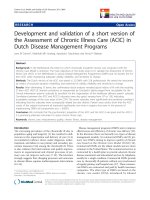
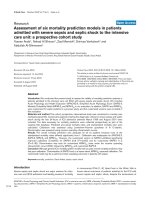
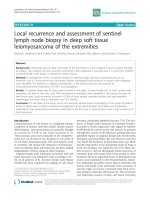
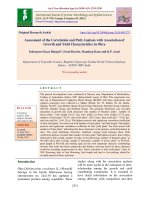

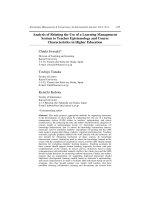
![Correlation and path coefficient analysis of fruits yield and yield attributes in okra [Abelmoschus esculentus (L.) Moench]](https://media.store123doc.com/images/document/2020_01/14/medium_ckb1578982226.jpg)
